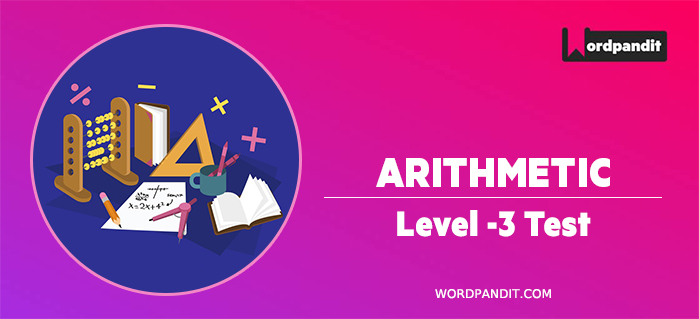- This is an assessment test.
- To draw maximum benefit, study the concepts for the topic concerned.
- Kindly take the tests in this series with a pre-defined schedule.
Arithmetic : Level 3 Test -7
Congratulations - you have completed Arithmetic : Level 3 Test -7.You scored %%SCORE%% out of %%TOTAL%%.You correct answer percentage: %%PERCENTAGE%% .Your performance has been rated as %%RATING%%
Your answers are highlighted below.
Question 1 |
The rate of inflation was 1000%. Then what will be the cost of an article, which costs 6 units of currency now, 2 years from now?
666 | |
660666 | |
720 | |
726 |
Question 1 Explanation:
The required cost = 6[1 + 1000/100]2
= 6(11)2 = 121 x 6 = 726
= 6(11)2 = 121 x 6 = 726
Question 2 |
A and B walk from X to Y, a distance of 27 km at 5 kmph and 7 kmph respectively. B reaches Y and immediately turns back meeting A at Z. What is the distance from X to Z?
25 km | |
22.5 km | |
24 km | |
20 km |
Question 2 Explanation:
Let they meet at a distance M kms. from X.
So total distance travelled by A = M at a speed of 5 kmph.
Total distance travelled by B = 27 + (27-M) = (54 – x) at a speed of 7 kmph.
Total time taken by A = M/5
Total time taken by B = (54 – x)/7.
Since they have met at the same time, they would have travelled for the same time.
Hence M/5 = (54 – M)/7 or M = 22.5 kms;
So total distance travelled by A = M at a speed of 5 kmph.
Total distance travelled by B = 27 + (27-M) = (54 – x) at a speed of 7 kmph.
Total time taken by A = M/5
Total time taken by B = (54 – x)/7.
Since they have met at the same time, they would have travelled for the same time.
Hence M/5 = (54 – M)/7 or M = 22.5 kms;
Question 3 |
Shyam went from Delhi to Shimla via Chandigarh by car. The distance from Delhi to Chandigarh is ¾ times the distance from Chandigarh to Shimla. The average speed from Delhi to Chandigarh was half as much again as that from Chandigarh to Shimla. If the average speed for the entire journey was 49 kmph. What was the average speed from Chandigarh to Shimla?
39.2 kmph | |
63 kmph | |
42 kmph | |
None of these |
Question 3 Explanation:
The distance from Delhi to Chandigarh is ¾ times the distance from Chandigarh to Shimla.
So the ratio of the distances between (Delhi-Chandigarh) : (Chandigarh-Shimla) = 3 : 4.
The ratio of the speeds between (Delhi-Chandigarh) : (Chandigarh-Shimla) = 3 : 2.
Let the distances be 3d & 4d respectively and speeds be 3r and 2r.
Time taken will be (d/r) and (2d/r) respectively.
Average speed for the entire journey was 49 kmph.
Therefore (7d)/ (d/r + 2d/r) = 7r/3 = 49.
Hence r = 21. So the average speed from
Chandigarh to Shimla = 2r = 42 kmph.
So the ratio of the distances between (Delhi-Chandigarh) : (Chandigarh-Shimla) = 3 : 4.
The ratio of the speeds between (Delhi-Chandigarh) : (Chandigarh-Shimla) = 3 : 2.
Let the distances be 3d & 4d respectively and speeds be 3r and 2r.
Time taken will be (d/r) and (2d/r) respectively.
Average speed for the entire journey was 49 kmph.
Therefore (7d)/ (d/r + 2d/r) = 7r/3 = 49.
Hence r = 21. So the average speed from
Chandigarh to Shimla = 2r = 42 kmph.
Question 4 |
A water tank has three taps A, B, and C. A fills four buckets in 24 mins, B fills 8 buckets in 1 hour and C fills 2 buckets in 20 minutes. If all the taps are opened together a full tank is emptied in 2 hours. If a bucket can hold 5 litres of water, what is the capacity of the tank?
120 litres | |
240 litres | |
180 litres | |
60 litres |
Question 4 Explanation:
Since a bucket holds 5 litres of water,
Water drawn by Tap A in 24 min = 20 l
That means it will exit 5/6 litres of water in 1 minute.
Water drawn by Tap B in 60 min = 40 l
That means it will exit 2/3 litres of water in 1 minute.
Water drawn by Tap C in 20 min = 10 l
That means it will exit 1/2 litres of water in 1 minute.
If A, B & C are all opened simultaneously, total discharge
= (5/6 + 2/3 + ½) = 2 litres in 1 minute.
So in 2 hours, the discharge would be 240 litres, which should be the capacity of the tank.
Water drawn by Tap A in 24 min = 20 l
That means it will exit 5/6 litres of water in 1 minute.
Water drawn by Tap B in 60 min = 40 l
That means it will exit 2/3 litres of water in 1 minute.
Water drawn by Tap C in 20 min = 10 l
That means it will exit 1/2 litres of water in 1 minute.
If A, B & C are all opened simultaneously, total discharge
= (5/6 + 2/3 + ½) = 2 litres in 1 minute.
So in 2 hours, the discharge would be 240 litres, which should be the capacity of the tank.
Question 5 |
After allowing a discount of 11.11%, a trader still makes a gain of 14.28%. At how many percentage above the cost price does he mark on his goods?
28.56% | |
35% | |
22.22% | |
None of these |
Question 5 Explanation:
So let the CP be Re 1.
Since he makes a profit of 1/7,(11.11% = 1/7) his SP
= (1 +1/7) = Rs. 8/7.
His marked price should be 1/9 above this.
So if we subtract 1/9 of MP from the MP, we will get the SP. So (MP –1/9 MP) = SP= 8/7
Hence, MP = 9/7
Therefore, percentage of mark-up on CP
= (MP – CP)/CP
= (9/7 – 1)/1
= 2/7 = 2 (1/7)
= 2 x 14.28
= 28.56 %
Since he makes a profit of 1/7,(11.11% = 1/7) his SP
= (1 +1/7) = Rs. 8/7.
His marked price should be 1/9 above this.
So if we subtract 1/9 of MP from the MP, we will get the SP. So (MP –1/9 MP) = SP= 8/7
Hence, MP = 9/7
Therefore, percentage of mark-up on CP
= (MP – CP)/CP
= (9/7 – 1)/1
= 2/7 = 2 (1/7)
= 2 x 14.28
= 28.56 %
Once you are finished, click the button below. Any items you have not completed will be marked incorrect.
There are 5 questions to complete.
List |




